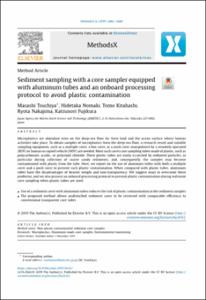Sediment sampling with a core sampler equipped with aluminum tubes and an onboard processing protocol to avoid plastic contamination

View/
Average rating
votes
Date
2019Author
Tsuchiya, Masashi
Nomaki, Hidetaka
Kitahashi, Tomo
Nakajima, Ryota
Fujikura, Katsunori
Metadata
Show full item recordAbstract
Microplastics are abundant even on the deep-sea
floor far from land and the ocean surface where human
activities take place. To obtain samples of microplastics from the deep-sea
floor, a research vessel and suitable
sampling equipment, such as a multiple corer, a box corer, or a push corer manipulated by a remotely operated
(ROV) or human occupied vehicle (HOV) are needed. Most such corers use sampling tubes made of plastic, such as
polycarbonate, acrylic, or polyvinyl chloride. These plastic tubes are easily scratched by sediment particles, in
particular during collection of coarse sandy sediments, and, consequently, the samples may become
contaminated with plastic from the tube. Here, we report on the use of aluminum tubes with both a multiple
corer and a push corer to prevent such plastic contamination. When compared with plastic tubes, aluminum
tubes have the disadvantages of heavier weight and non-transparency. We suggest ways to overcome these
problems, and we also pre.....
Journal
MethodsXVolume
6Page Range
pp.2662–2668Document Language
enSustainable Development Goals (SDG)
14.aMaturity Level
Pilot or DemonstratedDOI Original
https://doi.org/10.1016/j.mex.2019.10.027Citation
Tsuchiya, M., Nomaki, H., Kitahashi. T., Nakajima, R. and Fujikura, K. (2019) Sediment sampling with a core sampler equipped with aluminum tubes and an onboard processing protocol to avoid plastic contamination. MethodsX, 6, pp. 2662–2668. DOI: https://doi.org/10.1016/j.mex.2019.10.027 …Collections
The following license files are associated with this item:
 Repository of community practices in Ocean Research, Applications and Data/Information Management
Repository of community practices in Ocean Research, Applications and Data/Information Management
